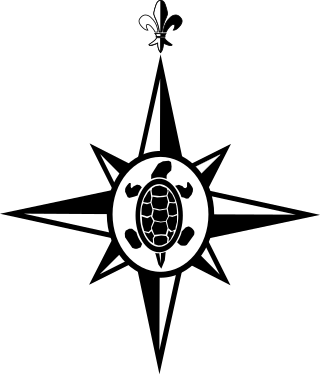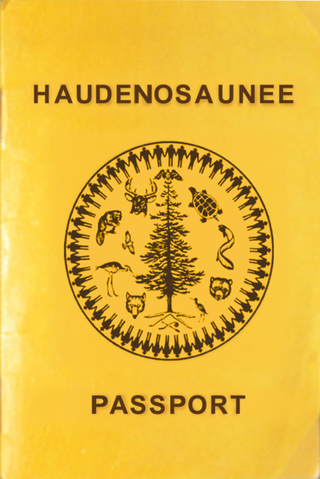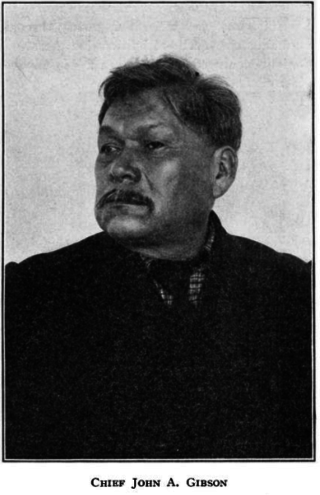
Mythology of the Haudenosaunee includes the creation stories and folktales of the Native Americans who formed the confederacy of the Five Nations Iroquois, later the Six Nations Iroquois Confederacy. Historically, these stories were recorded in wampum and recited, only being written down later. In the written versions, the spellings of names differ due to transliteration and spelling variations in European languages that were not yet standardized. Variants of the stories exist, reflecting different localities and times.

Hiawatha, also known as Ayenwatha or Aiionwatha, was a precolonial Native American leader and cofounder of the Iroquois Confederacy. He was a leader of the Onondaga people, the Mohawk people, or both. According to some accounts, he was born an Onondaga but adopted into the Mohawks.

Among the Haudenosaunee the Great Law of Peace, also known as Gayanashagowa, is the oral constitution of the Iroquois Confederacy. The law was written on wampum belts, conceived by Dekanawidah, known as the Great Peacemaker, and his spokesman Hiawatha. The original five member nations ratified this constitution near modern-day Victor, New York, with the sixth nation being added in 1722.

The Onondaga people are one of the five original nations of the Haudenosaunee (Iroquois) Confederacy in the Northeastern Woodlands. Their historical homelands are in and around present-day Onondaga County, New York, south of Lake Ontario.

Onondaga Lake is located in Central New York, immediately northwest of and adjacent to Syracuse, New York. The southeastern end of the lake and the southwestern shore abut industrial areas and expressways; the northeastern shore and northwestern end border a series of parks and museums.
The Covenant Chain was a series of alliances and treaties developed during the seventeenth century, primarily between the Iroquois Confederacy (Haudenosaunee) and the British colonies of North America, with other Native American tribes added. First met in the New York area at a time of violence and social instability for the colonies and Native Americans, the English and Iroquois councils and subsequent treaties were based on supporting peace and stability to preserve trade. They addressed issues of colonial settlement, and tried to suppress violence between the colonists and Indian tribes, as well as among the tribes, from New England to the Colony of Virginia.

The Haudenosaunee was formed around the Great Law of Peace Kaianere'kó:wa, a constitution detailing a shared value system which informs the policy and economics of their society.
The Great Peacemaker, sometimes referred to as Deganawida or Tekanawí:ta was by tradition, along with Jigonhsasee and Hiawatha, the founder of the Haudenosaunee, commonly called the Iroquois Confederacy. This is a political and cultural union of six Iroquoian-speaking Native American tribes governing parts of the present-day state of New York, northern Pennsylvania, and the eastern portion of the provinces of Ontario, and Quebec Canada, recognized as sovereign by both the USA and Canada.

The Two Row Wampum Treaty, also known as Guswenta or Kaswentha and as the Tawagonshi Agreement of 1613 or the Tawagonshi Treaty, is a mutual treaty agreement, made in 1613 between representatives of the Five Nations of the Haudenosaunee and representatives of the Dutch government in what is now upstate New York. The agreement is considered by the Haudenosaunee to be the basis of all of their subsequent treaties with European and North American governments, and the citizens of those nations, including the Covenant Chain treaty with the British in 1677 and the Treaty of Canandaigua with the United States in 1794.

Ganondagan State Historic Site, also known as Boughton Hill, is a Native American historic site in Ontario County, New York in the United States. Location of the largest Seneca village of the 17th century, the site is in the present-day Town of Victor, southwest of the Village of Victor. The village was also referred to in various spellings as Gannagaro, Canagora, Gandagora, Gandagaro and Gannontaa.

The Haudenosuanee 'Tree of Peace' finds its roots in a man named [Dekanawida], the peace-giver. The legends surrounding his place amongst the [Iroquois] is based in his role in creating the Five Nations Confederacy, which consisted of the Mohawks, Oneidas, Onondagas, Cayugas, and Senecas, and his place as a cultural hero to the Haudenosaunee Nation, commonly known in Western culture as "Iroquois". The official title of the confederacy is, Kayanerenh-kowa as described by Paul A. Wallace, "it is also known as Kanonsionni, a term that describes both its geographical extent and its constitutional form". The myths and legends surrounding Dekanawida have the roots in the oral histories that followed many Native American tribes throughout their histories.

Sainte Marie among the Iroquois was a 17th-century French Jesuit mission located in the middle of the Onondaga nation of the Iroquois. It was located on Onondaga Lake near modern-day Syracuse, New York. The original mission, led by Jesuit priest Simon Le Moyne, was in use only from 1656 to 1658.

Turtle Island is a name for Earth or North America, used by some American Indigenous peoples, as well as by some Indigenous rights activists. The name is based on a creation story common to several indigenous peoples of the Northeastern Woodlands of North America.

The Iroquois, also known as the Five Nations, and later as the Six Nations from 1722 onwards; alternatively referred to by the endonym Haudenosaunee are an Iroquoian-speaking confederacy of Native Americans and First Nations peoples in northeast North America. They were known by the French during the colonial years as the Iroquois League, and later as the Iroquois Confederacy, while the English simply called them the "Five Nations". The peoples of the Iroquois included the Mohawk, Oneida, Onondaga, Cayuga, and Seneca. After 1722, the Iroquoian-speaking Tuscarora people from the southeast were accepted into the confederacy, from which point it was known as the "Six Nations".

Tadodaho was a Native American Hoyenah (sachem) of the Onondaga nation before the Deganawidah and Hiawatha formed the Iroquois League, or "Haudenosaunee". According to oral tradition, he had extraordinary characteristics and was widely feared, but he was persuaded to support the confederacy of the Five Nations.

The Iroquois or Haudenosaunee passport is a passport issued by the Iroquois Confederacy.
Lyle Thompson is a Haudenosaunee professional lacrosse player from the Hawk Clan of the Onondaga Confederacy of the Six Nations of the Grand River. His native name is Deyhahsanoondey, which translates into He's Flying Over Us. He plays both indoor and outdoor professional lacrosse. In professional outdoor lacrosse, he plays at the attack position for the Cannons Lacrosse Club of the Premier Lacrosse League. In professional indoor lacrosse, he plays at the forward position for the Georgia Swarm of the National Lacrosse League. He also competes internationally in both indoor lacrosse for Haudenosaunee men's national indoor lacrosse team, and outdoor lacrosse for the Haudenosaunee men's national outdoor lacrosse team.

John Arthur Gibson (1850–1912) was a chief of the Seneca nation of the North American Iroquois confederation. Part Onondaga and part Seneca, he resided within the reserve of the Six Nations of the Grand River in Ontario, Canada. Knowledgeable about Iroquois (Haudosaunee) culture, he is best known for the versions he provided of the Iroquois oral constitution, the Great Law of Peace. He acted as an advisor to the Canadian Department of Indian Affairs in matters relating both to Iroquois and non-Iroquois indigenous people. He was a well-respected player of the traditional Iroquois sport of lacrosse until he was blinded during a game when he was 31.

The Haudenosaunee Nationals Indoor Lacrosse Team, known as the Haudenosaunee Nationals, represents the Iroquois Confederacy in international box lacrosse competitions. They are currently ranked second in the world by World Lacrosse and have won silver medals in all five World Indoor Lacrosse Championships. The team is organized by the First Nations Lacrosse Association.
Leon Shenandoah was an Onondaga politician who headed the Haudenosaunee (Iroquois) Confederacy from 1968 to his death.















